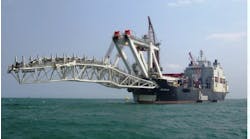Offshore staff
WALLINGFORD, UK – Fugro GEOS has won a contract to provide Qatar Shell with round-the-clock support and maintenance support for a seabed water temperature monitoring system.
The new equipment, which Fugro GEOS designed and installed, is part of thePearl GTL (gas-to-liquids) project in Ras Laffan, jointly developed by Qatar Petroleum and Shell.
It helps manage flow assurance problems in pipelines linking the two Pearl offshore platforms with the onshore plant.
Through use of acoustic telemetry, data are sent from the seabed to the platforms and the system interfaces in real-time with the platform’s control system. When the seabed water temperature reaches a pre-determined level, an alarm triggers allowing action to be taken to manage and maintain the flow of gas through the pipelines.
Pearl GTL involves exporting natural gas under pressure over a distance of 60 km (37 mi) from the unmanned platforms. The compressed gas flows through the pipelines, in a water depth of around 30 m (98 ft), to the onshore complex in Ras Laffan Industrial City.
When the seabed water temperature falls, hydrate crystals can form in the pipeline, potentially impeding the flow of gas and causing structural damage. Injecting kinetic hydrate inhibitors mitigates hydrate formation and minimizes the risk of pipeline blockages.
“Monitoring the seabed water temperature has contributed to maintaining a steady flow of feed gas from the offshore platforms to the onshore facility,” said Anthony Gaffney, director of Fugro GEOS’ Offshore Systems Division.
“The ability to accurately measure the water temperature along the export pipelines and identify when kinetic hydrate inhibitors are needed eliminates the need to purchase, transport, store, pump and then remove the inhibitors, and this translates into cost savings.
“Because our monitoring system does not require divers for deployment or recovery, it is readily retrofitted and recovered so intervention costs are minimized and safety is enhanced. Also, as the system uses acoustic telemetry, there is no requirement for subsea cables which may suffer damage and which would be costly to replace over the lifetime of the project.”
Local 24-hour support in Qatar is provided by service engineers from associate company Petrotec.
2/16/2012


